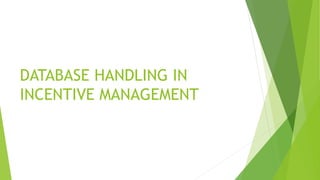
PS-1 Final PRESENTATION
- 1. DATABASE HANDLING IN INCENTIVE MANAGEMENT
- 2. Hindustan Aeronautics Limited, Barackpore Division 9, Topkhana Road Barrackpore. Kolkata - 700120
- 3. INTRODUCTION Hindustan Aeronautics Limited (HAL) is a state- owned aerospace and defence company with its head office situated in Bangalore. It is managed by the Indian Ministry of Defence. The set of activities falling under the umbrella of this organization include manufacturing and assembly of aircraft, navigation and related communication equipment and their repairmen. Its various products include MIG aircraft, Sukhoi aircraft, Cheetah and Chetak helicopters, Tejas and Marut aircrafts, etc.
- 4. HAL, BARRACKPORE DIVISION Part of Helicopter Complex under Bangalore Division of HAL Established as repair base in 1940 Became part of Hindustan Aircraft Pvt. Ltd. In 1951 Associated with repairing and overhaul of Cheetah and Chetak and Lancer helicopters. Various departments – Accessories, Radio & Instrumentation, Computer (IT) and Final Assembly Has 2 hangars of 6000 sq. Mts. area each equipped with all facilities for repair and even production of helicopters if need be.
- 5. VARIOUS SERVICES: Major Servicing (3200 hrs.) of Cheetah, Chetak and Lancer helicopters of Indian Air Force, Indian Army, Indian Navy and Indian Coast Guard T1SI (400 hrs.) and T2SI (800 hrs.) Servicing of Chetak Helicopters of Indian Navy and Indian Coast Guard Repair, Servicing and Overhaul of Rotables Directly from customers Other HAL Divisions Assembly of new Cheetah and Chetak helicopters Repair, Servicing and Overhaul of
- 6. Propellers Constant speed governor In-situ repairs of helicopters Scheduled and unscheduled servicing of helicopters Supply of RMSO items Supply of Rotables/spares against AOG demands Supply of Ground Handling and Ground Service Equipment Assistance during Investigation of Accidents/Incidents and Defects
- 7. DATABASE MANAGEMENT SYSTEM Manages very large amounts of data Supports efficient access to very large amounts of data Supports concurrent access to very large amounts of data Example: Banks and their ATM machines Supports secure, atomic access to very large amounts of data
- 8. WHY NOT FILE SYSTEM? Data redundancy and inconsistency Difficulty in accessing data Data isolation Integrity problem Atomicity problem Concurrent-access anomalies Security problems
- 9. APPLICATION OF DBMS BANKING: For customer, information, account and loans, and transaction Airline: For reservation and schedule information. Airline were among the first to use database in a geographically distributed manner terminals situated around the world accessed the central database system through phone lines and other data network Universities: For students information, course registration, and grades (our very own ERP System in BITS Pilani is an example of DBMS) Credits card transaction: For purchases on credits cards and generation of monthly statements Sales: For customer, product, and purchase information Human resources: For information about employees, salaries, payroll taxes and benefits, and for generation of paychecks
- 10. HAL DATABASE The databases in Hindustan Aeronautics Limited, Barrackpore that we are dealing with: Employee Master Employee Job Docket Monthly Job Card Job Pending List Job Acceptance List Monthly Pay List Monthly Not-Paid List
- 11. EXAMPLES
- 12. INCENTIVE MANAGEMENT Employees apply for jobs using Job Cards which gets stored in the database of the specific month. More than one employee can apply for a single job. Based on each employee’s Job Docket entry and comparing them with the specific job’s time requirement, their Standard Man Hour (SMH) for the given job is filed. At the end of a month the effective SMH an employee has worked in a job is received. If the job is completed and is accepted by the customer, it goes to the ‘Monthly Pay List’ and the employee gets paid according to the effective SMH that he gave to the job. If the job isn’t completed or if it is not accepted by the customer, it goes to the ‘Not Paid List’ and subsequently is added to the ‘Pending Jobs List’ which is a cumulative file continued from months. Using these, we calculate the tag and ceil for each employee which lead us towards the final incentive calculation process taking various other factors into account. Everything is presented in the form of a report in the end for each employee.
- 13. PROJECT SEQUENCE Creation of nfile from the raw entry file using various checks – pb number check, work order check, time check, serial number check Second, we created the jobcard entry file from the raw JCAA file applying similar checks on the data set. Combining the nfile and jobcard gave us the bmmyy file of smh calculation smh being the standard man hour (effective hours for each employee). Creation of the frhr and frhr_cumulative files containing the frhr_factor calculated as per the following formula: time (where code = 10) / time (code = 10 + code = 11) Obtaining the smmyy file from the bmmyy file and the frhrc files.
- 14. B.dat file made by combining the nwns and smmyy files. Bpaymmyy (incentive to be paid) and Bnotpaid (incentive payment to be held) files were created using the B.dat file and the wopn file (received). Twip cumulative file from the jobcard and nfile. Tag calculation from the bpaymmyy file – stored in tag and tag_cumultive files. Ceil calculation for the direct employees using the Attendance file (created from raw file) – stored in arc and arc_cumulative files. Rpyc file – comparison of tag and ceil on the following basis: if (tag >= ceil) ceil gets inserted into rpyc else tag gets inserted into rpyc Finally, the calculation of total incentive to be paid in rupees and updating the report for each employee.
- 15. Main Terminologies Used: The knowledge of CURSORS for sequential traversal of records in PL/SQL Oracle Database. The extensive use of FUNCTIONS in SQL – both in-built and made by us. The basic knowledge of the declaration and definition of a PL/SQL block.
- 16. THANK YOU